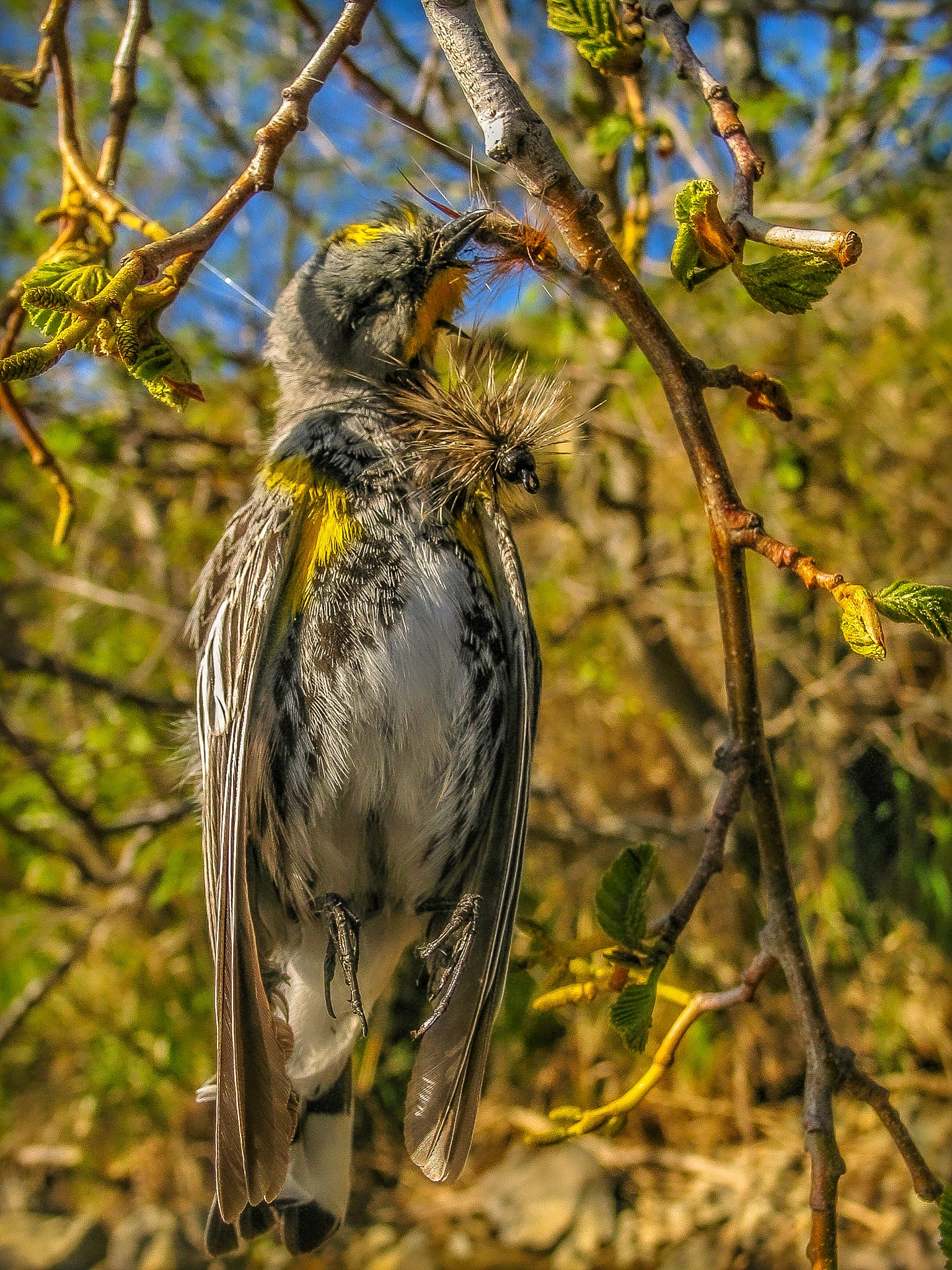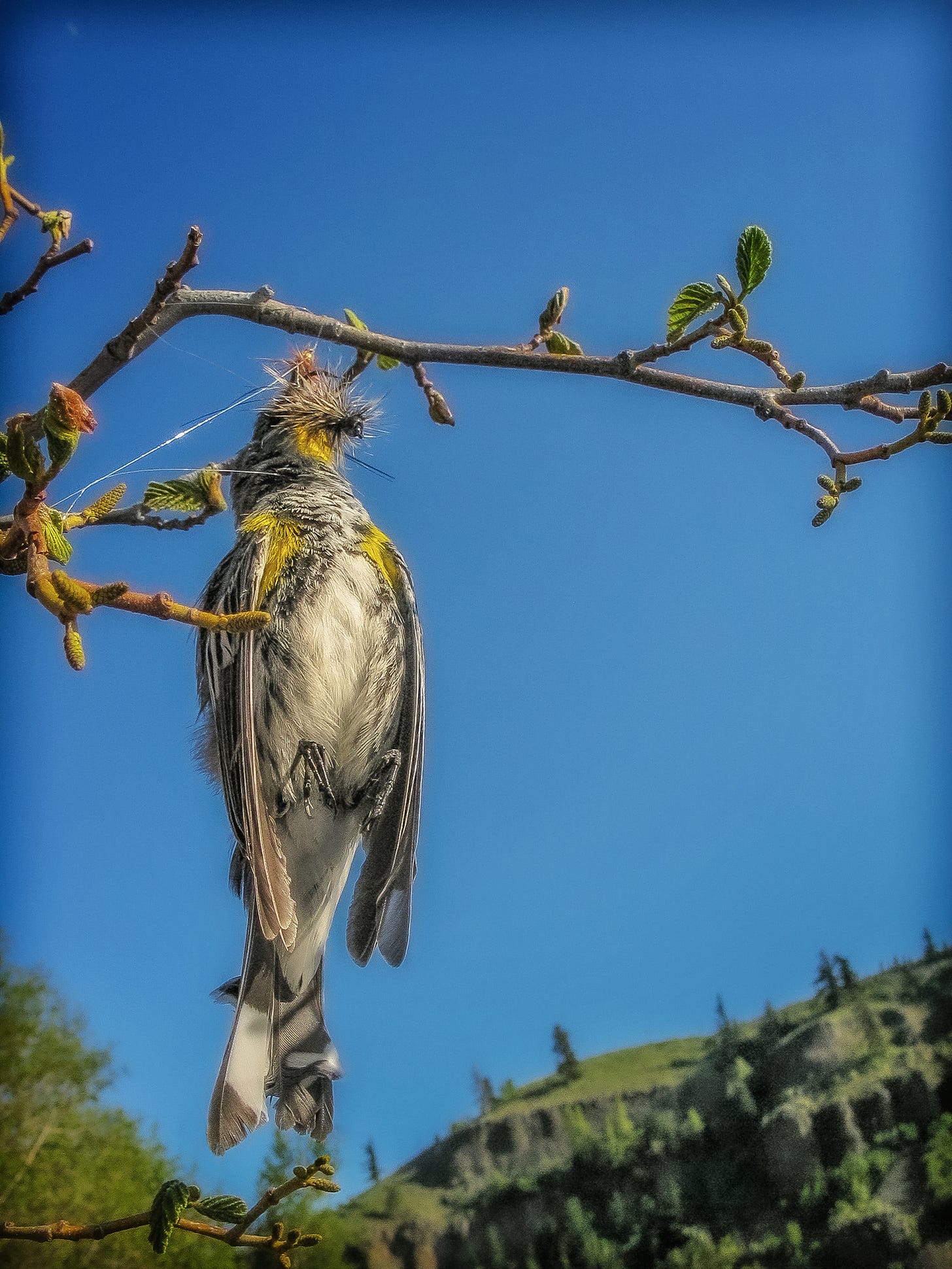The Wake We Leave Behind
Unintended Consequences and Collateral Damage
Yakima River, Central Washington:
A yellow-rumped warbler hangs dead from a fly-fisherman’s broken off flies twenty feet above the river; an unintended consequence.
One can decipher this story’s principal events easily, even while having witnessed none of them as they were unfolding. Some aspects of any story are almost certain. Others, we are free to make up, fill in on our own, according to the nuances of our personal imaginings.
Certainly, we have no idea here of the color of the fisherman’s shirt that day or the length of his or her hair. Nor could anyone tell you with certainty whether the exhaled fog of our fisherman’s breath in the moment of his errant cast smelled of coffee in frosty, morning air or beer in the warm sunlight of mid-afternoon. Was this person married or single one might wonder? Does it matter? A father? Mother? Grandparent? None of these details are known to us, and all, in the end are mostly unimportant, except as they help us visualize a larger story and attempt to place ourselves within it.
We can know that our fisherman was careless. Study that weighted, beadhead fly that has pierced the warbler’s throat and you will see that there is no no telltale, broken-off knot in the hook’s eye, meaning it was a poorly tied knot that gave way and not the monofilament leader. And notice the barbed hook which is illegal on this ‘catch and release only’ stretch of river …for exactly the reasons you can see here. Barbed fishhooks do not allow themselves to be backed out of whatever flesh they might pierce without great damage that flesh, and because of that, their uses are considered citation-worthy offenses by fish and game officers. All this fly rig’s flinger would have needed to do was pinch down that lethal barb with a set of needle-nose pliers, either when they tied the fly, or if purchased, when it was added to the fly box, or tied onto the leader.
This barbed hook detail alone almost guarantees that the fisherperson in question was not fishing from the boat of a professional guide. No reputable fishing guide would ever tie up a fly rig so carelessly.
I’d bet money that our fisherman was casting from a drift boat, but it could also have been an inflatable raft with a standing floor. Whichever it was, given the sloppy placement of this lethal tandem of beautifully tied and broken off flies, and their distance above the fishy stretch of river below, one can almost certainly assume this fisherperson was standing while casting, and from a point well out in the river, You can also assume that the boat, which almost certainly someone else was rowing, was moving downstream at the pace of the current, rather than anchored up. The water was moving too fast out there for a comfortable anchoring and was much too deep to wade.
When you’re drifting like that and you accidentally snag a tree limb some distance away, it’s very difficult to stop in time to untangle and retrieve your flies, so you simply herk on your rod to break them off, having planned into your calculations from the get-go that a certain number of flies are going to be lost to errant casts and snags, sacrificed to the river gods and vagaries of flycasting on the move. Experienced flyfishers factor in the need for multiples of each pattern in their fly boxes, and anticipated fly loss is baked in, based on the patterns you’ll be fishing and the number of miles you’ll float. No one, generally speaking, loses much sleep about such things.
This exquisite little songbird, Setophaga coronata, aka, yellow-rumped warbler, which undoubtedly came upon these imitation insects while foraging for real ones, mistook them for a meal and then, cruelly gored by that razor-tipped, still-barbed hook point, flapped futilely against the nearly invisible bondage of thin, 4x, monofilament tippet, which is designed to tether and battle fish far heavier and more powerful than he.
Eventually this frantic, terrified, wounded little songbird ran out of flaps, released its hold on life and became another feathered bit of flotsam in yet another outdoorsman’s deadly wake.
Most of us have little idea of the wakes we create and leave behind, those unseen, unintended trails of consequences flowing outward from our well-intended, nature-loving, outdoor excursions.
We hear hand-wringing comments like “We’re loving our parks and wildernesses to death.” and sometimes listen to military figures on the evening news speak haltingly of ‘collateral damage’ in active war zones, but inevitably picture someone who is not us, while tsk-taking their careless and costly behaviors. Our personal encounters with nature are sacred and beautiful. They are calming and lend evidence to all who look on of our nature-loving wholesomeness. We are the good guys in our outdoor adventure stories, after all, making donations to our favorite conservation and nature organizations, ordering our outdoor gear from eco-minded companies like Patagonia and REI. No way are we assholes, careless killers and polluters like those jerks who toss their beer cans and granola bar wrappers in the brush or let their dogs crap alongside the trail without picking it up when no one is watching.
As a fly fisherman of more than forty years I have certainly broken off hundreds of flies that I never managed to retrieve, both above and below the water’s surface. I have no clear idea how many fish, or how many other animals might have suffered or died within the wakes of my fishing adventures, but it is likely, many. Some of that is just inherent in the process. I don’t love knowing that. It weighs on me more heavily now than when I was younger. I work harder to do better.
Still, I continue to fish, though not as much, and continue to find those hours spent standing in or alongside a river, tying knots and tossing flies to be some of the most calming and meditative that I know how to afford. But each new fishing adventure since that cool, spring morning is now informed by what you see in these photographs, after having found and mourned, retrieved and finally buried that beautiful little, hook-gored warbler that I came upon accidentally when I looked up and saw it hanging lifeless in that riverside tree.
I am ever more aware that my wholesome, outdoor adventures nearly always carry certain dark possibilities for others, that my care or lack of it imposes itself upon each world I step, momentarily into and then leave. But I can control parts of that. I can tie careful knots, make good choices and always pinch down the hook barbs on my flies.
I can try to minimize those unseen wakes I leave behind me, impose as little as possible that will mark the lives of other creatures, indelibly with the invisible ink of my visits.




This reverence and regard for all the various lives you meet shows such a kind spirit! This is goodness, to notice when a beautiful, or even not-so-beaituful, one has passed; to pay attention that way. I love how you, with intention, do what you can to minimize your own impact. Yes, sacred stuff, this.
The way of fly fishing is new and interesting to me---but the illegal, barbed fish hooks being used by thoughtles persons makes me so sad and mad as I imagine this beautiful warbler's struggle & demise. Your images are so potent. Thank you---I take it all in---and remind myself to wander as softly as I can...
Poignant and insightful. Makes me stop reflect and think about where I can be more conscious. 💗